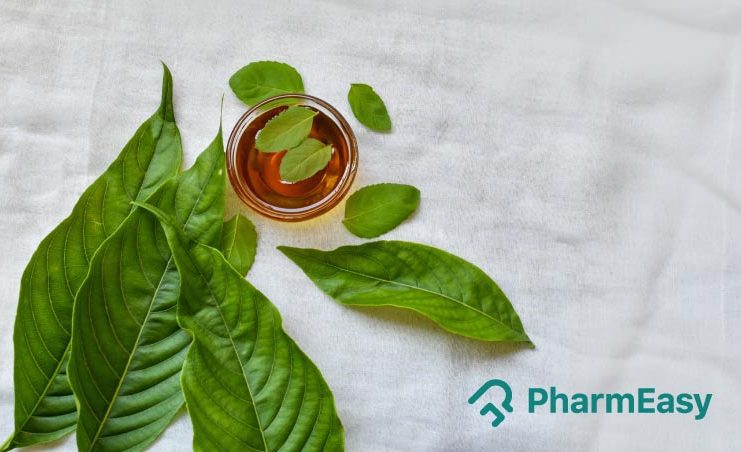Vasaka (Malabar Nut): Uses, Benefits and Side Effects by Dr. Rajeev Singh
By Dr Rajeev Singh +2 more

Get,

to manage your symptom
Get your,


4 Cr+ families
benefitted

OTP sent to 9988776655



You’ve successfully subscribed to receive
doctor-approved tips on
Whatsapp

Get ready to feel your best.

Hi There,
Download the PharmEasy App now!!


Register to Avail the Offer
Send OTPBy continuing, you agree with our Privacy Policy and Terms and Conditions

Hi There,
Sign up on PharmEasy now!!
Trusted by 4 crore+ families

OTP sent to 9988776655



You have unlocked 25% off on medicines




Code: NU25
By Dr Rajeev Singh +2 more
Table of Contents
Vasaka is also known as Malabar nut, a crucial plant drug in ancient Ayurveda and Unani medicine. Vasaka has its references in the Atharvaveda. Vasaka leaves, bark, roots, and flowers have been used in the preparations of herbal medications for the past 2000 years. The Vasaka plant is a small, evergreen shrub with green leaves and white flowers with an unpleasant smell and bitter taste. It is native to India’s dry climates and dry soils. It happily grows at the foothills of the Himalayas, Sri Lanka, Burma, and Malaysia. In Vasaka, ‘vasa’ translates to ‘perfumes’ from its flowers. Vasaka in Sanskrit botany is known as “lion’s muzzle” and “stallion’s tooth” both names honour the plant’s strength. The scientific name of Vasaka is Justicia adhatoda (Adhatoda vasica). The other terms of Vasaka are Arusa, Adulsa, Vasika, and Vajidanta1,4. Let us discuss Vasaka’s benefits, nutritional composition, and potential uses.

The nutrients of Vasaka may include:
Further, the bioactive compounds may include alkaloids, steroids, flavonoids, tannins, terpenoids and saponins2,4.
Vasaka may consist of the following properties:
The following may be some of the potential uses of vasaka:

Persistent cough and congested lungs may cause discomfort. Vasaka may be considered herbal aid for the common cold and flu. Vasaka may use as a base ingredient in various cough syrups. Vasaka juice with little honey produces a soothing action on the throat. Its expectorant properties help loosen the phlegm deposits in the lung airways2. If you have a bad cough or cold, get appropriate medical treatment and do not use it to self-medicate.
Vasaka is commonly used in Ayurveda and has many medicinal properties. It may a potent medicine against various diseases like cough, bronchial asthma, diabetes mellitus, mental health diseases, acid reflux, and alcoholism.
Dr. Siddharth Gupta, B.A.M.S, M.D (Ayu)

Vasaka leaves decoction may contain two major alkaloids, vasicinone and vasicine. Animal studies by Shivendra Pratap Singh and Das in 2021 found that Vasaka might have activity against respiratory disorders such as asthma and bronchitis. It may have broncho-dilatory properties, which might open the airway passage of the lung. It may liquify the thick and sticky sputum, help expel it quickly and release congestion. In asthma, the dried leaf may be smoked for instant relief1,4. However, human research is needed to suggest the benefits of Vasaka for asthma and bronchitis. Consult a qualified physician and take appropriate medical treatment.

Research suggests that Vasaka may have wound-healing activity. In an animal study, Vasaka plant extracts were applied to the wound. It was found that the rate of wound healing was increased. The tensile strength of the skin and the production of skin collagen and elastin may also be increased. Vasaka leaves poultice (bandage) may be applied on the fresh wound or inflammatory swelling might help reduce microbial infections and may heal the wounds1,3. Still, more human research is needed to develop its uses for wound healing.

Vasaka may have antiulcer activity. An animal study by Shrivastava et al. 2006 found that Vasaka leaf powder may reduce animal peptic ulcers. Vasaka may be used to regulate both internal and external bleeding, such as peptic ulcers2. However, no such results are seen in humans more clinical research is required to suggest the true significance of Vasaka in healing peptic ulcers. If you have peptic ulcers, consult your doctors.

Vasaka plant may have anti-tubercule activity. Therefore, it may help inhibit the activity of Mycobacterium tuberculosis. In addition, a study by Grange and Snell in 1996 found that Vasaka may contain Vasicine alkaloid and its semi-synthetic derivatives (bromhexine and ambroxol) with other essential oils. These bioactive compounds may possess the highest activity against tubercle bacilli. Hence, it might be a useful adjuvant in the therapy against tuberculosis3. Tuberculosis is a serious disease; it requires appropriate diagnosis and medical treatment. If you suffer from tuberculosis, take medical help.

Though studies show the potential uses of Vasaka in various health conditions, more is needed and there is a need for further studies to develop the scope of the benefits of Vasaka on human health.
Vasaka, commonly known as Justicia adhatoda may have anticancer properties. Some studies show that Vasaka possesses flavonoids and phytochemicals when extracted from its leaves6.
Dr. Rajeev Singh, BAMS
You may use Vasaka in the following ways:
You should consult a qualified Ayurvedic doctor before having Vasaka in large quantities. Also, do not discontinue or replace an ongoing medical treatment with an Ayurvedic/herbal preparation of Vasaka without consulting an Ayurvedic physician. They will guide you with its form and dosage as per your health condition.
No significant studies reported the side effects of Vasaka in humans. More human studies are needed to suggest the Vasaka side effects. Vasaka might be considered safe when used in the recommended dosage. However its safety in children has yet to be tested therefore, it should not be given to children2. You must consult your doctors to get the proper treatment if you encounter any side effects.
One must have Vasaka only if recommended by doctors. Taking it in small quantities might be safe. However, general precautions are necessary:
Also Read: Red Sandalwood: Uses, Benefits, Side Effects and More By Dr. Smita Barode
Vasaka herb preparations should not be taken with other drugs that may act similarly to an expectorant or have antispasmodic effects. It may produce drug-drug interactions, leading to harmful effects2. Therefore, you should avoid having Vasaka herbal preparations with any medicine, and if any complications arise, consult with Ayurvedic doctors.
Also Read: Guggul: Uses, Benefits, Side Effects and More!
Vasaka in Hindi is called Arusa or Adosa, in Marathi Adulsa or Vasuka, in Gujarati Adusoi, in Bangali Baksa, in Tamil Vasambu and in Telgu Addasaramu2,3.
The key component of Vasaka may include Quinazoline alkaloid. Other components may include vasicinone, vasicinol, adhatodine, adhatonine, steroids, triterpenes, flavonoids, carbohydrates and alkanes2,3.
The Vasaka plant may have properties such as antimicrobial, antibacterial, analgesic, anti-inflammatory, anti-asthmatic, antiulcer, anti-diabetic, antitubercular, antioxidant, anticancer and wound-healing activity. It may also act as a bronchodilator (open the airway of the lungs) and as an expectorant (remove cough)3,4. If you have the above problems consult the doctor and do not self-medicate.
Vasaka may contain vitamin C and carotene, providing Vasaka with its antioxidant activity2.
Vasaka syrup may help clear out the airway in the lungs and help expel the cough. Vaskak leaf decoction may be taken with honey might relieve irritable cough2. If you have a bad cough, consult a doctor and get proper medication.
Disclaimer: The information provided here is for educational/awareness purposes only and is not intended to be a substitute for medical treatment by a healthcare professional and should not be relied upon to diagnose or treat any medical condition. The reader should consult a registered medical practitioner to determine the appropriateness of the information before consuming any medication. PharmEasy does not provide any guarantee or warranty (express or implied) regarding the accuracy, adequacy, completeness, legality, reliability, or usefulness of the information; and disclaims any liability arising thereof.
Links and product recommendations in the information provided here are advertisements of third-party products available on the website. PharmEasy does not make any representation of the accuracy or suitability of such products/services. Advertisements do not influence the editorial decisions or content. The information in this blog is subject to change without notice. The authors and administrators reserve the right to modify, add, or remove content without notification. It is your responsibility to review this disclaimer regularly for any changes.
Comments

Leave your comment...
You may also like
Comments